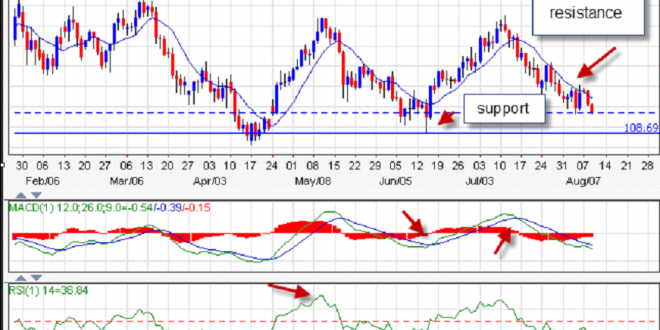Online trading indicators – beginners guide
Online forex trading can be enjoyable and profitable, but you need some investing techniques to improve your chances of having success. You can use online trading indicators in conjunction with evaluating new information to improve your ability to generate profitable trades. But understanding momentum and sentiment, as well as support and resistance, you can improve your trade entry as well as your risk management.
Support and Resistance
The forex markets bounce around every day as investors enter and exit exchange rates, finding the equilibrium price where buyers and sellers are content. When new information becomes available, an exchange rate will quickly move to a new equilibrium level. When demand is strong and prices cannot move lower, a currency pair has found support. When supply is robust, and prices cannot move higher, an exchange rate has found resistance.
Support and resistance can come in many forms. It can be a daily or weekly low, or a moving average or trend line. A moving average is the average of a specific number of data points over a certain period. For example, the 10-day moving average takes the average of the last 10-days and on day eleven, the first day is dropped. The 10-day moving average in the chart of the USD/JPY above is considered resistance. A trend line can be upward sloping, downward sloping or horizontal. The horizontal trend line at 108.69 on the USD/JPY chart is seen as support.
Momentum
Momentum describes the acceleration in prices action. If you think about a train, it slowly picks up speed, and at the point just before it reaches its maximum speed, the acceleration is at its highest. One of the best indicators that can help evaluate momentum is the moving average convergence divergence index known as the MACD. The MACD helps evaluate momentum by evaluating the difference between two exponential moving averages, and determining when the moving average spread is crossing above or below the exponential moving average of that spread.
The chart of the USD/JPY shows red arrows when the MACD generated a crossover buy and sell signal. The crossover can be used as a trading signal as it describes a period when momentum is changing and is accelerating in a different direction. The sell signal occurs when the spread (the 12-day exponential moving average minus the 26-day exponential moving average) crosses below the 9-day exponential moving average of the spread. The buy is the reverse signal, and you get a crossover buy signal.
Sentiment
Sentiment is another indicator that is often used by traders to help that determine if the market is about to change direction. When an exchange rate is over bought or oversold, sentiment has reached a peak or trough and is likely to change direction. The relative strength index (RSI) can help traders determine if the market is too frothy or too depressed. The RSI is an index that fluctuates between 1 and 100. Levels above 70 are considered overbought while levels below 30 are considered oversold. In the chart of the USD/JPY the red arrows depict areas where the exchange rate is overbought and oversold.
By using several technical indicators in conjunction with new information, you can help yourself increase your trading acumen, and become a more successful trader.
 Forex Winners | Free Download Downlod free trading sysrems , indicators and forex E-books
Forex Winners | Free Download Downlod free trading sysrems , indicators and forex E-books

